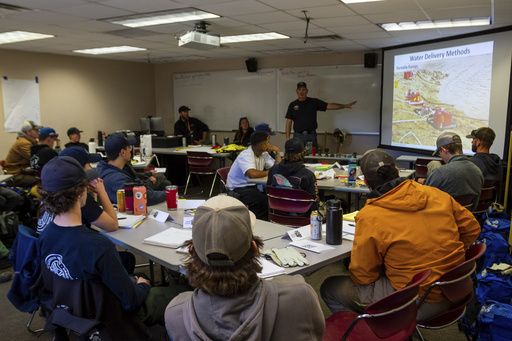PRESCOTT, Ariz. (AP) — It’s shaping up to be a long wildfire season, with Texas already seeing its largest blaze in recorded history and firefighters becoming overwhelmed with recent blazes in Virginia.
Just in the first three months of the year, more than 2,669 square miles (6,912 square kilometers) were charred in the United States. That’s more than half of last year’s total, and forecasters are predicting elevated risk of fires over the coming months in the Great Lakes region, parts of the Midwest, Southwest and in Hawaii.
“We’re going to be busy. I couldn’t tell you exactly where right now, but we are going to be busy,” said Alex Robertson, acting director of fire and aviation at the U.S. Forest Service.
With fires growing in size and duration, federal officials in charge of juggling resources and dispatching crews are pivoting to a new business model they describe as the biggest shift in wildfire management in decades. They say it will offer more flexibility when responding to wildfires and ensure that there are more personnel with the training and qualifications needed to deal with the most complex fires.
It’s an idea that has been circulating for years due to the strain put on the wildland firefighting workforce as heat waves and historic drought tied to climate change have made wildfires harder to fight in the American West. Scientists have said climate change has made the region much warmer and drier in the past 30 years and will continue to make the weather more extreme, and wildfires more frequent and destructive.
In past years, a shortage of top-level Type 1 teams has resulted in Type 2 teams taking on bigger assignments — like those that threaten multiple communities and require more firefighters, aircraft and a constant stream of other resources. This season, 44 leadership teams have been formed to respond to the largest fires across the country.
Managers consider many factors when deciding a fire’s complexity, which can change amid developments ranging from fuel conditions and growth potential to risks to property and cultural resources.
Todd Abel, the deputy fire management officer with Arizona’s Department of Forestry and Fire Management, has been part of wildfire management teams for more than two decades. There have been years when he returned home from an assignment only to pack up and leave again two days later for another one. He recalled doing that eight or nine times one summer.
“That’s why they’re making more teams available for complex incident management,” he said.
In 2021, California marked its largest single wildfire. The Dixie Fire was active for more than three months and grew to 1,505 square miles (3,898 square kilometers). Nearly 2,000 personnel were assigned to that fire.
The following year in New Mexico, more than 3,000 people were assigned to fight the Hermit’s Peak/Calf Canyon Fire, a conflagration sparked by two prescribed burns that escaped from forest managers. The largest and most destructive wildfire in New Mexico’s recorded history, it burned for more than four months before it was contained.
Aside from filling top command roles, recruitment of new wildland firefighters has been a priority across federal land management agencies. Many positions are seasonal, averaging six months. Some people don’t return while others are promoted — and both cases leave positions empty.
The Forest Service hopes to hire around 11,300 firefighters this year.
The lengthening of fire season also has changed the makeup of seasonal fire crews and permanent positions. Jeff Rupert, director of the U.S. Interior Department’s Office of Wildland Fire, said that in years past, more than one-third of the workforce consisted of seasonal crew members. That number is decreasing as more permanent positions are required.
New recruits must complete wildland fire training and pass a basic fitness test.
An annual wildfire training academy in Prescott, Arizona, marked a record-setting year, with more than 1,000 people turning out in March for a week of classroom time and work in the field.
Dozens of students kicked up clouds of dust as they used tools to dig their first handline in a place where fire is simulated by pink tape tied to bushes. There wasn’t any choking smoke or chainsaws ripping through the brush while helicopters thundered overhead. Still, the workshop provided students with an idea of what it’s like to fight a wildfire.
Robertson said the first year for a firefighter is the most important.
“It’s when somebody determines whether this line of work is good for them,” he said. “It’s a lot of work where you don’t know where you’re going to be the next day. It’s very dynamic. A lot of unknowns.”
For top-level managers who orchestrate battles against the largest fires, there are new courses that some will have to take — now that Type 1 and Type 2 teams are being reconfigured to form new management teams for complex fires. Between 50 and 90 people will make up the teams, each with expertise in their particular fields.
Jesse Bender, chair of the Incident Workforce Development Group, said the change has to do more with the administrative process of how government agencies respond to wildfires. She called it an opportunity to better align the business of fighting wildfires so the public knows it’s getting a highly trained and experienced group of people who can take care of firefighters on the ground and protect the things that communities value, including homes, wildlife, cultural landmarks and nature reserves.
“The bottom line,” she said, “is we want to make sure we get enough people to all the fires to help those who need it.”
___
Associated Press writer Susan Montoya Bryan in Albuquerque, New Mexico, contributed to this report.


